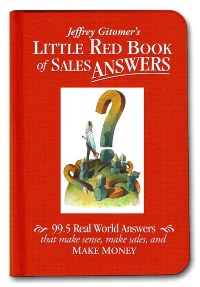How to make sales calls on social media. Kind of.
Letter from a fan:
Hello Mr. Gitomer, I read your article on LinkedIn in the Daily Herald Business Ledger here in the Chicago Suburbs. I am a fan. You make great points and observations that many people miss. I’m in the process of retooling my profile. I can’t help but to ask if you have ever made a sale through LinkedIn? Thanks, Kyle
The simple answer is YES. But it ain’t that simple.
I have a business brand, a personal brand, and a social brand. All of which are interconnected. All of which are mature. All of which provide value messages. All of which create attraction. All of which generate leads. All of which make sales.
MY MARKETING MANTRA IS THE CORE OF MY SOCIAL EFFORT: I put myself in front of people that can say ‘yes’ to me and I deliver value first.
Long before social media, or as I prefer to refer to it business social media, my marketing mantra was the hallmark of my sales success. As a writer and speaker in the early ’90s, I built my brand in print media and created attraction through value messaging. Still do.
It was hard to create attraction (leads and sales) if you weren’t in print.
The HUGE difference (and your advantage) is that now there are a variety of additional media and social media outlets available. Most of them are free. And you can become attractive on all of them, if you choose the right path.
The value messaging path.
The path that will attract the all-important CLICK.
CLICK means someone wants to see more.
Especially if they’re looking to buy or connect.
CLICK AROUND: There are very few ‘one source’ sales anymore. Too many options available. People, you included, click around before they connect, interact, and especially buy.
The omnipresence of mother Google, combined with the advent of business social media, has created new and better ways to search, find, connect, attract, and interact. And one social media outlet proves, promotes, and reinforces the other to someone that clicks around.
Everyone clicks around.
People searching do not just search one source. They keep searching until they find comfort enough to click, and click again in the same spot. And my value messages promote multiple clicks.
ONE CLICK MEANS NOTHING. One click means you get a ‘look.’ Two or more clicks on the same page or site gets a deeper look and maybe a connection. Especially in social media.
If I’m looking for someone or something, I click ALL their social media. Don’t you?
NOTE: Your customers, your prospects, and your potential connections are clicking you. And you can’t stop them.
NUMBERS MATTER: The number of followers and connections you have can be the difference between click and no click. Your prospect is seeking some comfort and assurance that you are safe to connect with or do business with.
COMMENTS, RATINGS, RECOMMENDATIONS, AND ENDORSEMENTS MATTER MORE THAN NUMBERS: Especially in the business world. If you have 500 business connections on LinkedIn, it pales in comparison to who has recommended and endorsed you. Recommendations and endorsements are proof. So are positive ratings and comments. And many businesses live and die by them.
RULE OF THE MORE THE MORE: The more a prospective customer clicks on you and your stuff, the easier it is for them to make a buying decision in your favor. They are more likely to click if your site is easy to navigate, your information is easy to understand, there is clear value to the possible purchaser, and you offer social and video proof that others have purchased from you and love it.
FINAL POINT OF UNDERSTANDING: Building and growing your ‘attraction platform’ is not just about what you say, post, or do; it’s all about what OTHERS think of what you say, post, and do combined with what actions THEY take as a result of it.
Do they post a favorable a comment? Do they re-tweet to their followers? Do they share with their connections? Do they ‘like’ you or what you do? Will they subscribe? And (of course) will they buy?
Those are the actions I seek to achieve in those who click on me.
Am I perfect at it? Heck no.
Do I work on making it better every day? Heck yes!
“OK, SO DID YOU MAKE A LINKEDIN SALE?” No, I made hundreds of them. I have more than 15,000 connections on LinkedIn, and EVERY DAY I post a value message.
Here’s what happens: People comment, people share the post with THEIR connections, people email me, and people call our office. EVERY DAY. And whether they want a twenty-dollar book or a fifty-thousand-dollar training program, the cost of that lead (and that sale) was ZERO.
Understand it was a value message that created the attraction and the sale(s), not an ad or a self-promoting message. Yes, I send out an occasional sales offer, but it’s less that 10% of the time. No one is gonna re-post an ad.
Next week you’ll see the detail of what my social game plan is, how one element ties into and supports the other, and how that creates attraction that leads to sales.
Stay tuned…
Reprinted with permission from Jeffrey H. Gitomer and Buy Gitomer.
About the Author


